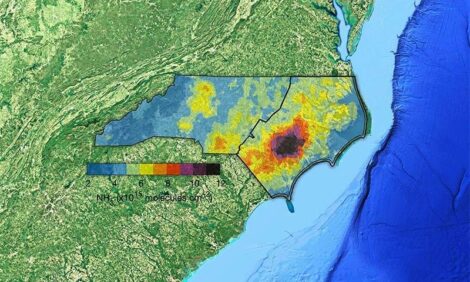



Economic and Structural Relationships in U.S. Hog Production
By William D. McBride and Nigel Key, U.S.D.A., ERS - Agricultural Economic Report No. (AER818) - Rapid change in the size and ownership structure of U.S. hog production has created new and varied challenges for the industry. This report describes an industry becoming increasingly concentrated among fewer and larger farms, and becoming more economically efficient. These changes have not come without problems.

|
The increasing market control and power concentrated among packers and large hog operations, and the manure management problem posed by an increasing concentration of hog manure on fewer operations, are paramount concerns.
Addressing these concerns through regulations would likely impose economic costs that could be passed on to consumers. In addition, the relative mobility of the hog industry means that regulations could result in significant changes in the location of hog production facilities, with ripple effects in local economies.
Balancing environmental and economic interests will challenge policymakers dealing with the implications of structural change in U.S. hog production.
Executive Summary
Rapid change in the size and ownership structure of U.S.
hog production has created new and varied challenges for
the industry. Once dominated by many small operations
as part of traditional crop-hog farms, hog production has
become highly concentrated on large operations with pro-duction
on several different sites. As of 2002, nearly half
of the U.S. hog inventory was owned by operations with
more than 50,000 head.
This report assesses key economic and structural issues
affecting U.S. hog production. Much of the report uses
information from previous research on economic and
structural issues in hog production to establish a context
within which to present information obtained from a
national survey of U.S. hog producers. This report pres-ents
detail about indicators, contributing factors, and
implications of structural change in hog production, and
addresses some of the economic and policy issues impor-tant
to agriculture.
The main findings of this report are:
- The rapid and widespread growth of contract hog pro-duction
has substantially raised productivity in the
industry. On average, contracting raises total productiv-ity
by 20-23 percent and by as much as 50 percent for
some inputs. The increase in productivity may result
because contracts facilitate the exchange of information
between contractors and growers. This information
exchange may involve knowledge about feed mixtures
or feed timing that results in higher feed productivity
and lower labor costs. It is also possible that the goods
and services provided by contractors, such as veterinary
care, feed, and, especially, the genetic quality of the
animals, may be superior to those typically used by
independent producers, resulting in healthier animals
and more efficient weight gain.
- The higher level of productivity associated with con-tracting
implies that responding to concerns about con-tracting
with policies that regulate or restrict contract-ing
would likely impose economic costs on the hog
industry and could cause pork prices to rise. However,
negative producer welfare effects (e.g., loss of auton-omy)
or costs to contracting (e.g., increased transaction
costs) could offset the potential on-farm efficiency gains
from contracting. Off-farm or non-market costs, such as
the environmental impact of an increased concentration
of animal waste, may also result because of contracting.
Available information is not adequate to quantify the
overall benefits and costs to society of policies that
restrict contracting.
- The returns to contracting for contractors and contract
growers have been largely determined by factors that
affect the efficiency of the hog operation, but the size of
contracts has not significantly impacted the returns of
either party. Production capacity utilization and feed
efficiency have had a significant impact on the returns
of both contractors and growers. The organization of
the contractor's business and the education of the
grower have also been important determinants of the
returns to contracting. However, the evidence does not
suggest that contractors have offered more favorable
terms to larger versus smaller grower operations.
- The potential for excess nutrients resulting from the
concentration of hogs on the land is much higher in
Southern States than in traditional hog-producing
States of the Corn Belt, and among larger versus
smaller operations. It is likely that nutrient loading
rates from manure match or exceed the utilization capa-bility
of the crops grown on many large farms and on
many farms in the South.
- Many hog producers could comply with more stringent
regulations on manure management by spreading
manure on more of their crop acreage. On average,
manure was spread on less than 30 percent of the crop
acreage on hog farms. However, the technology used to
handle manure on most operations in the South limits
the ability to spread manure over more acreage at the
same cost. Also, more than half of large operations in
the South would still be loading nitrogen at the upper
limit of crop utilization if manure were spread over all
available acreage.
- If alternative or innovative manure management tech-nologies
are required to comply with more stringent reg-ulation,
large and independent operations are in a much
better position than small and contract grower opera-tions
to make the necessary capital investments.
Economies of size in hog production allow large opera-tions
to spread the fixed investment for manure manage-ment
facilities over more units of output. Contract grow-ers,
with lower net farm income and less equity than
independent producers of the same size, are less able to
afford additional capital investments for manure man-agement.
Thus, contractors may need to become more
involved with manure management or growers may need
to locate other sources of capital.
- The trend toward fewer, larger, and more productive
hog operations will likely continue into the foreseeable
future. Many of the highest cost hog operations are
small, independent operations, operated by older pro-ducers
who plan to soon exit the hog industry. The
lowest cost operations are mostly large, produce under
contract, and are operated by younger producers with
newer facilities.
- The managerial ability of individual hog producers is
probably as important as size economies in lowering the
costs of hog production. There is substantial variation in
production costs that cannot be attributed to size of
operation. The distribution of costs by size of operation
indicates that, despite higher average costs among small-and
medium-sized operations, many of these operations
can produce hogs at a cost that is competitive with larger
operations.
- The comparative disadvantages that an area may have in producing hogs can be overcome with innovative technologies and business arrangements, making the hog industry highly mobile and able to locate where market and/or regulatory conditions are more favorable. Despite higher feed prices in the South and West, cost advantages associated with improved productivity and size economies offset this disadvantage and have spurred growth of the industry in these areas. This mobility also means that hog production could locate to other areas of the Nation or out of the country should market and/or regulatory conditions warrant.
These findings paint a picture of an industry increasingly
concentrated among fewer and larger farms, and becom-ing
more economically efficient. However, these changes
have not come without problems. Concerns about the
increasing market control and power concentrated among
packers and large hog operations, and from the manure
management problem posed by the increasing concentra-tion
of hog manure on fewer operations, are paramount.
Addressing these concerns through regulation would
likely impose economic costs that could be passed on to
consumers. In addition, the relative mobility of the hog
industry means that regulations could result in changes in
the location of hog production facilities, with ripple
effects in local economies. Balancing environmental and
economic interests appears to be a major challenge for
policymakers dealing with the implications of structural
change in U.S. hog production.
Links to Information in this report ...
Chapters are in Adobe Acrobat PDF format and open in new browser.Frontmatter (Abstract, Acknowledgments) (above/below)
Contents (Here)
Executive Summary (above)
Introduction (98 Kb)
Factors Contributing to Structural Change
Implications of Structural Change
A Roadmap
Background (69 Kb)
Structural Change
Public Policy Concerns: Market Conduct
Public Policy Concerns: The Environment
Indicators of Structural Change
Organizational Innovation
Technological Innovation
Factors Contributing to Structural Change (649 Kb)
Variation in Production Costs
Structural Characteristics by Cost Group
Performance by Cost Group
Economies of Size
Structural Characteristics by Size Group
Performance by Size Group
Regional Diversity
Structural Characteristics by Region
Performance Characteristics by Region
Contract Production
Structural Characteristics by Business Arrangement
Performance by Business Arrangement
Contract Arrangements for Finishing Hogs
Implications of Structural Change (58 Kb)
Contract Production and Industry Productivity
Potential Impacts of Contracting on Productivity
Findings: Contracting and Productivity
The Costs and Returns to Contracting
Distribution of Contracting Costs and Returns
Findings: Returns to Contracting
Manure Management and the Environment
Manure Management Technologies
Manure Application and Crop Production
Paying for Manure Management
Findings: Industry Structure and Manure Management
Glossary (14 Kb)
References (25 Kb)
Appendix I: Measuring Hog Production Costs (15 Kb)
App. II: Modeling the Impact of Contract Production on Productivity (98 Kb)
App. III: Modeling the Returns to Contract Production (30 Kb)
Entire Report (903 Kb)
Order this report (stock #ERSAER818)
Acknowledgments
The authors thank Leland Southard, Noel Gollehon, Jim MacDonald, Marv
Hayenga, Kitty Smith, Ralph Heimlich, Jim Johnson, Marc Ribaudo, and Gerry
Grinnell for their thoughtful reviews and helpful comments. We are also grateful to
Lou King for his valuable and prompt editorial assistance, and to Anne Pearl for
her design work.
Source: U.S.D.A., ERS - February 2003







